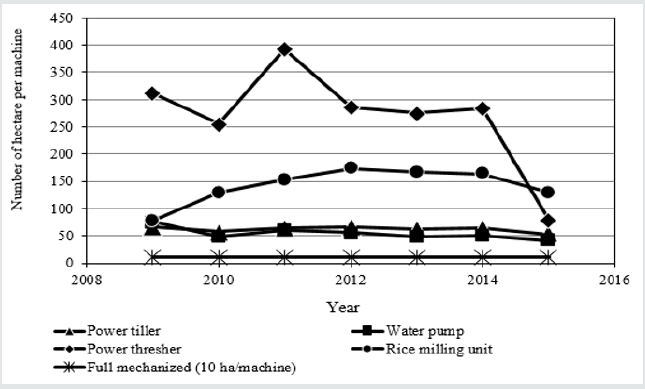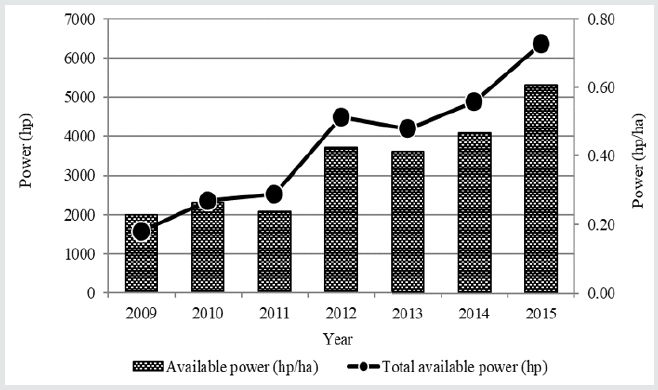
Lupine Publishers Group
Lupine Publishers
Menu
ISSN: 2637-4676
Research Article(ISSN: 2637-4676) 
Farm Machinery and Power Availability for Mechanizing Small-Scale Rice Farming Cultivations in Kampar Region, Indonesia Volume 8 - Issue 2
Ujang Paman*
- Department of Agribusiness, Riau Islamic University, Indonesia
Received: January 27, 2020; Published: February 05, 2020
Corresponding author: Department of Agribusiness, Riau Islamic University, Indonesia
DOI: 10.32474/CIACR.2020.08.000282
Abstract
Farm machinery is one of important power sources for performing various farm operations today. The availability of adequate farm machinery is essential for providing sufficient power on the farm. Thus, the various farm operations can be well-mechanized and can contribute to the overall improved productivity of crops. This study attempted to examine the farm machinery and power availability for mechanizing small-scale rice farming operations in Kampar Region, Indonesia. Data were collected through field survey in the selected rice production centers in the region. The interviews with involving farmers, government extension staff and machinery suppliers were conducted in 2015. The results showed that small type of farm machinery is mostly demanded by farmers, including power tillers, water pumps, power threshers, and rice milling units (RMUs). The machines are suitable to farm conditions that are small in size and purchasing power of farmers. However, the number of farm machinery available was not sufficient to provide power requirements for mechanizing overall rice farm operations. Public financial support and private sector involvement are strongly needed to promote farm machinery use among small scale farmers.
Keywords: Farm machinery demand; Power requirement; Small rice farm; Kampar region
Introduction
Agriculture has undergone modernization across the
world. Agricultural mechanization is an important element
for modernization of the agriculture [1] and plays a key role in
improving agricultural production in developing countries [2].
Farm mechanization implies the use of mechanical technology in
the varied farming operations [3] and then takes the place of human
and animal power in agricultural processes. Essentially, agricultural
mechanization represents technological change through the
adoption of nonhuman sources of power to undertake agricultural
operations [4]. Energy (power) is one of the most valuable inputs
in production agriculture [5]. The technical change from human
and/or animal power to machine power in agriculture will tend
to increase machinery demand of farmers. Power and machinery
are an integral part of modern agriculture, so the development of
the machines used in the modern agriculture has also brought new
demands on farmers [6].
The mechanization of farming, particularly in developing
countries, has been very uneven [7]. In Indonesia, agricultural
mechanization is currently still in the developing stage and its
development speed remains slow and differs across the country.
Slow development process in the country may be caused by some
constraints, including socioeconomic, technical, and institutional
constraints [8]. Consequently, the level of mechanization in the
country was relatively low with an average level of 30% [9]. In
Riau Province, Paman, et al. [10] reported that the mechanization
degree was only about 28% in 2013. The low mechanization level
in the province may be caused by shortage number and application
of farm machines by farmers. During a period of 2009-2013, the
number of major farm machines in the province, including tractors,
water pumps, power threshers and rice milling units, increased
from 5,610 units to 6,371 units or increased at about 6% annually
[11].
According to Handaka [9], the mechanization development
in Indonesia would follow and highly depended upon the process
of national economic development. Government support has also
significantly contributed to the advancement of farm machinery use among farmers through primarily financing for farm machinery
purchase. It means that the improvement of farmers’ economic
condition as a result of economic growth will tend to increase
demand of farm machinery that has highly powerful and efficiency.
Farm machinery is also required to fulfill an energy requirement
for performing various farm operations. A worldwide study has
concluded that for optimum yields, there is a need for a power input
at least 0.8 hp. ha-1 [12]. In addition, demand for mechanization
depends on some factors, such as farming system intensity, the
availability of complementary technologies, and the capacity to fully
use machines [4] Sufficient availability of the right energy (power)
and its effective and efficient use are prerequisites for improved
agricultural production [13]. This study attempted to examine the
farm machinery and power availability for small-scale rice farming
operations in Kampar Region, Indonesia. This is important to meet
the needs of farmers of farm machinery as a source of power for
effective and efficient farm operations.
Materials and Methods
This study was carried out in Kampar, one of the 12 regions in
Riau Province, Indonesia. The region consists of 21 districts and
250 villages with total area of 11.289,28 sq-km. Total population
is 371.449 with a density of 30 sq-km-1. Kampar region is the most
important area because it is one of the major rice production area
in the province. Farm machines have been used in the area for many
years and tend to increase from year to year.
This study was carried out in 15 selected districts from of 21
districts in Kampar Region. A purposive sampling technique was used for selecting the locations. The selected districts are predominantly
rice production areas using semi irrigation or rain-fed system. The
interviews with involving farmers, government extension staff
and machinery suppliers (dealers) were conducted in 2015. The
primary data were collected using structured questionnaires. Data
collected include paddy field areas, rice production and yield, and
type and number of farm machines. Secondary data were obtained
from the records of the local government such as statistical bureau,
food crop and fishery services, and district offices. Data collected
were analyzed using descriptive statistics that were employed with
mean and percentage.
Results and Discussion
Rice area and production
Rice is not main crop in Kampar region. However, rice is an important crop because it is a staple food for most people. Rice is mostly grown on the technical irrigation farm and rain-fed low land with 1 – 2 cropping systems in a year, depending on climate conditions. Figure 1 depicts that paddy field area could not cultivated completely every year due to shortage labor, farm machines, capital, and climate conditions. The largest cultivated area was in 2011 ha and then declined to the lowest area in 2015. Similarly, rice production fluctuated every year during a period of 2009-2015. The highest production occurred in 2012 to be 52,154 tons and the lowest one was 29,666 tons in 2014. However, the rice production fluctuates depending upon the climatic conditions. In 2014, El-Nino hit Indonesia, which caused drier conditions over the country and crop losses.
Figure 1: Total paddy field area and production in Kampar Region during 2009-2015.
Source: Food Crop and Fishery Services [11].
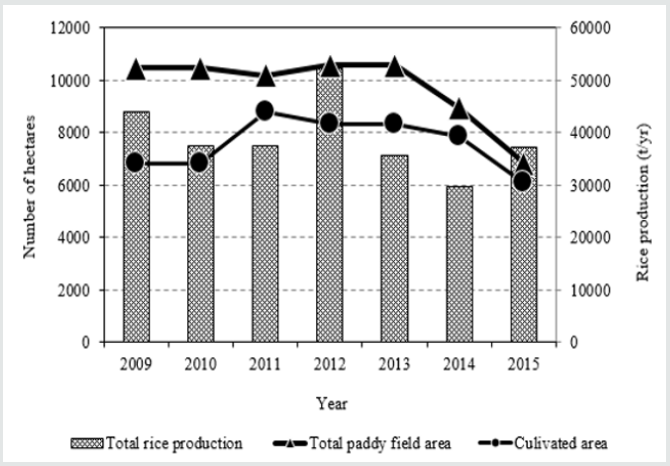
Farm machinery availability
Rice farming in Kampar region is dominated by small-scale operations, so small type of farm machinery dominantly used by farmers for an economical operation. The use of farm machinery was to perform primarily power-intensive operations such as land preparation, irrigation, threshing, and milling. Therefore, types of farm machinery available on farm mostly include power tillers, water pumps, power threshers, and rice milling units (RMUs). Water pumps, for example, accounted to 254 units (38%) in 2015, and followed by power tillers (29%) and power threshers (20%) in the same year. Meanwhile, both combine harvesters and reapers are still an introduction stage for rice farmers in the survey area. Development of the above types of farm machinery during a period of 2009-2015 is presented in Table 1 and Figure 2. Generally, the number of farm machines increased at about 15% annually. The highest growth was power threshers to about 55% annually, followed by water pumps (23%) and power tillers (13%). Furthermore, RMUs increased by only 1% annually. This machine is used along year with different volume of work for each month [14].
Figure 2: Total number of available machines and rice productivity during 2009-2015
Source: Food Crop and Fishery Services [11]
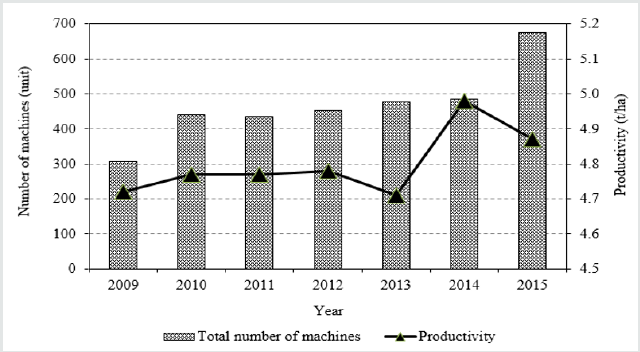
Table 1: Farm machinery development in Kampar region during 2009-2015.

Source: Food Crop and Fishery Services [11].
Figure 2 shows the development of farm machinery and rice
productivity (crop yield) during 2009-2015. The total number
of farm machines increased from 307 units in 2009 to 675 units
in 2015 with an annual increase of 15%. The increased number
of farm machines did not show a significant effect on increasing
rice productivity during the period. Although the number of
farm machines increased significantly during the period, the rice
productivity increased at a low rate during the same period and even
declined to be the lowest rate of 0.5% annually in 2013. Moreover,
when the number of farm machines increased at the highest rate in
2015, the rice productivity showed to decrease, and it was lower
than 2014. These conditions may be due to still an inadequate
number of farm machines in the region. Increasing supply of
farm machines is needed to achieve an adequate number of farm
machines and then make a significant effect on rice productivity.
Farm machinery used by small farmers in Kampar Region
is generally owned by individual farmer and farmer group.
According to Figure 3, the individual owned was dominant
in the Kampar region and their machines were purchased by themselves from dealers. The farm machinery which was owned
by a farmer group came from direct government aid through the
mechanization development program. The farm machines bought
by the government were distributed to farmer groups to be used
for custom hiring, especially for servicing group members [15].
The farm machines managed by individual farmers were bought
itself and the excess capacity was provided to other farmers for
providing the farm machinery hire services. The service charge
differed between group farmers and individual farmers, and the
group farmers offered lower rates compared to individual farmers.
The machinery hire services are an alternative use to economically
adjust ownership of the machines and obtain an additional income
from the services. This machine hire business was reported to be
profitable under individual management [16] as well as farmer
group management [10].
Figure 3: Farm machinery ownership system in Kampar region.
Source: Food Crop and Fishery Services [11]
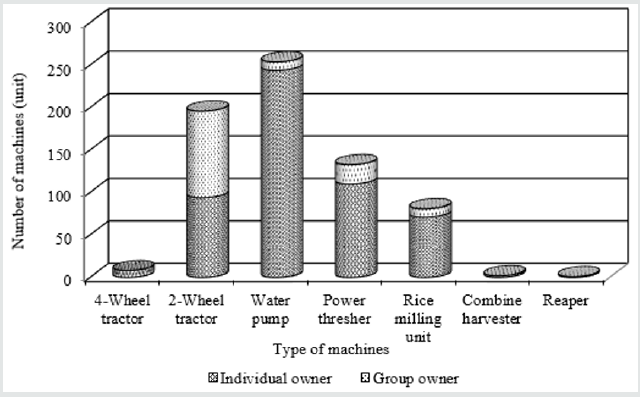
As outlined above, the number of available farm machines is still inadequate to make a significant increase of rice productivity in Kampar region. Figure 4 shows development number of hectares per machine in the region during 2009-2015. During the period, power threshers and rice milling units show the lowest number of hectares per machine. However, the density of both machines increased in 2015 due to increase number of the farm machinery on the farm. Consequently, the number of hectares per machines became to be 129 and 41 for power threshers and rice milling units, respectively. It means that the density of farm machinery increased according to increase the number of available machines. While, both power tillers and water pumps did not show significantly to increase machine density during the period. Generally, the density of the farm machinery has not been enough to achieve full mechanized for rice farm operations. Herdt [17] stated that to achieve full mechanization stage, for example, it requires about 100 power tillers per 1000 hectares (or 10 ha per power tiller). The result showed that the number of available power tillers in Kampar region was no sufficient to achieve full mechanization stage.
Farm power availability
The available power in the region is expressed as a number of horsepower per hectare (hp.ha-1). Farm power availability is directly related to the amount of power needed to perform farm operations. The availability of machine power during a period of 2009-2015 in Kampar region is presented in Figure 5. The total number of machine powers in the region increased from 1,566 hp (1,168 kW) to 6,356 hp (4,740 W) with an increasing rate of about 29% annually. This power sourced from large/medium tractors, power tillers, water pumps, power threshers, rice milling units, combines, and reapers. The water pump had the largest contribution to the power, followed by power tillers and rice milling units. The number of the available power depends strongly on the number of farm machines. Based on the total power availability, available power per hectare also increased from 0.23 hp.ha-1 (0.17 kW.ha-1) to 0.61 hp.ha-1 (0.45 kW.ha-1) with an increasing rate of 21% annually. This number is not sufficient to make optimum rice yield which required at least 0.8 hp.ha-1 [12]. Comparing with Iran, for example, the available power has reached at the level of 0.86 kW.ha-1 [18]. The result suggests that the number of farm machines must be increased to meet power requirement for rice farm operations.
Conclusion
The number of farm machinery on farm is inadequate to provide a sufficient power for rice farm operations in Kampar region. Consequently, human power still remains as an important source of farm power in many areas in across the region. The increasing number of farm machines has no significant effect on rice productivity. Nevertheless, the insufficiency of available farm machines did not create demand of the machines. Furthermore, the shortage of farm machines affected the availability of power per hectare. The available machine power is still under the power requirement for achieving a maximum rice yield. However, the number of farm machines must meet the needs of small rice farmers. Therefore, government support is still required to the advancement of farm machinery in Kampar region.
References
- Verma M, Tripathi A (2016) Perspective of the Status of Agricultural Mechanization in the Bihar State. International Journal of Emerging Technology & Research 3(3): 10-17.
- Mehta CR, Chandel NS, Senthilkumar T (2014) Status, Challenges and Strategies for Farm Mechanization in India. Agricultural Mechanization in Asia, Africa, and Latin America 45(4): 45-50.
- Iqbal MA, Iqbal A, Afzal S, Akbar N, Abbas RN, Khan HZ (2015) In Pakistan, Agricultural Mechanization Status and Future Prospects. American-Eurasian Journal Agricultural & Environment Sciences 15(1): 122-128.
- Diao X, Silver J, Takeshima H (2016) Agricultural Mechanization and Agricultural Transformation. International Food Policy Research Institute (IFPRI), Washington, DC, USA.
- Khambalkar V, Pohare J, Katkhede S, Bunde D, Dahatonde S (2010) Energy and Economic Evaluation of Farm Operations in Crop Production. Journal of Agricultural Science 2(4): 191-200.
- Jacobs CO, Harrell WR (1983) Agricultural Power and Machinery. McGraw-Hill, Inc. New York, USA.
- Binswanger H (1986) Agricultural Mechanization: A Comparative Historical Perspective. Research Observer 1(1): 27-56.
- Hendriadi, A (2009) Country Report of Indonesia. Ministry of Agriculture. Republic of Indonesia. Jakarta.
- Handaka (2005) Agricultural Engineering Research and Development in Indonesia: Challenge and Prospect toward Sustainable Agriculture and APCAEM program. Paper presented in APCAEM TC/GT Meeting in New Delhi, India 21-24.
- Paman U, Inaba S, Uchida S (2016) Economic Aspects of Machinery Hire Services Managed by Farmer Groups in Kampar Regency, Indonesia. Applied Engineering in Agriculture 32(2): 169-179.
- Food Crop and Fishery Services (2014) Serial Data of Food and Horticulture in 2013. Pekanbaru, Indonesia.
- Jain BKS (1979) Tractors in Indian Agriculture - Their Place and Problem. Agricultural Mechanization in Asia, Africa, and Latin America, Autumn Issue 31-34.
- Himanshu SK, Kumar S, Kumar A, Gupta KK (2012) Energy Economics Assessment of Crops in Traditional and Mechanized Farming. International Research Journal of Environment Sciences 1(5): 27-34.
- Paman U, Bahri S, Asrol Liana L (2016) Distribution and Use Patterns of Small-Scale Rice Mills in Kampar Regency, Riau Province, Indonesia. International Journal of Advanced Science Engineering Information Technology 6(2): 149-152.
- Paman U, Inaba S, Uchida S (2014) Farm Machinery Hire Services for Small Farms in Kampar Regency, Riau Province, Indonesia. Applied Engineering in Agriculture 30(5): 699-705.
- Paman U, Uchida S, Inaba S (2010) Economic Potential of Tractor Hire Business in Riau Province, Indonesia: A Case Study of Small Tractors for Small Rice Farms. Agricultural Engineering International: CIGR Journal 12(1): 135-142.
- Herdt RW (1983) Mechanization of Rice Production in Developing Asian Countries: Perspective, Evidence, and Issues. In Consequences of Small-Farm Mechanization; International Rice Research Institute and Agricultural Development Council, Los Banos, Philippines P. 1-13.
- Ghadiryanfar M, Keyhani A, Akram A, Rafiee S (2009) A Pattern for Power Distribution Based on Tractor Demand in Iran. Agricultural Engineering International: The CIGR Journal of Scientific Research and Development 11: 1-9.

Top Editors
-

Mark E Smith
Bio chemistry
University of Texas Medical Branch, USA -

Lawrence A Presley
Department of Criminal Justice
Liberty University, USA -

Thomas W Miller
Department of Psychiatry
University of Kentucky, USA -

Gjumrakch Aliev
Department of Medicine
Gally International Biomedical Research & Consulting LLC, USA -

Christopher Bryant
Department of Urbanisation and Agricultural
Montreal university, USA -

Robert William Frare
Oral & Maxillofacial Pathology
New York University, USA -

Rudolph Modesto Navari
Gastroenterology and Hepatology
University of Alabama, UK -

Andrew Hague
Department of Medicine
Universities of Bradford, UK -

George Gregory Buttigieg
Maltese College of Obstetrics and Gynaecology, Europe -

Chen-Hsiung Yeh
Oncology
Circulogene Theranostics, England -
.png)
Emilio Bucio-Carrillo
Radiation Chemistry
National University of Mexico, USA -
.jpg)
Casey J Grenier
Analytical Chemistry
Wentworth Institute of Technology, USA -
Hany Atalah
Minimally Invasive Surgery
Mercer University school of Medicine, USA -

Abu-Hussein Muhamad
Pediatric Dentistry
University of Athens , Greece

The annual scholar awards from Lupine Publishers honor a selected number Read More...




